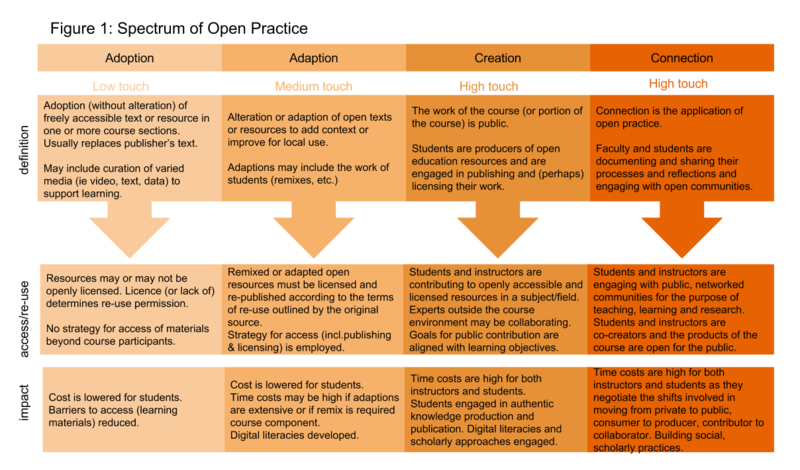Documentation:Open UBC/Teach/What
Teaching in the open means that you are making some or all aspects of your learning environment available and accessible to the public. For some, this may mean the adoption of an open text or learning resource, or contributing open educational resources created by you and/or your students. For others, it may mean adopting a set of open practices - related to all aspects of the course including planning, learning, assessment and reflection on the process. In general, openness exists on a spectrum.
Spectrum of openness in a learning environment

- Low touch vs. high touch: the concept of "touch" that we have articulated here refers to notions of interaction between and among participants in the course as well as interactions with "public" communities and individuals. This may also have an impact on the design effort related to the course. For example courses supporting interaction with various external communities and resources over a period of time (wikipedia editing; publishing on YouTube; etc) require a high touch approach to the design and also to the ongoing support of those interactions.
Open resources
Not all open resources are created equal! If you want your resource to have the most flexibility for re-use, you will need to design it with that in mind (See: Creating Open Education Resources). This means conscious application of an open license and using formats (for video, etc.) that can easily be edited. Often, a first step to open is to make existing teaching resources freely available to students at the start of class. These are often pdf "textbooks" that are posted in the course website but are not yet licensed OERs (open educational resources), made findable by the public. It's important to know that open licensing and the use of open formats are important in meeting the 5R permissions characteristic of OERs that allow others to build on and improve them over time.
Types of open resources
 |
 |
 |
Open assignments
One can also go a bit further into the realm of open teaching, beyond using open resources in courses. Many of these involve posting work publicly, but without an open license that allows others to revise and reuse it. Please see the licensing guide for instructors for more information on open licenses.
- One could post teaching materials such as syllabi and assignment instructions on a publicly viewable site, but without an open license.
- One could ask students to do course assignments on open platforms such as blogs (e.g. UBC Blogs) or wikis (e.g., UBC Wiki); these are publicly available but may not automatically have open licenses attached
- Students might post some of their coursework publicly, without an open license
- One could open up parts of a course to the public for discussion.
- For example, one might allow comments on student blog posts that are open to anyone to contribute to (they can also be moderated to avoid spam and other unwanted comments).
See how to teach in the open section of this website for more information on how to incorporate these kinds of activities in a course.
Open practice
"Open practice" is a term that could actually cover any open teaching and learning activities, but we are using it here to designate teaching and learning activities that are further towards the "fully open" side of the spectrum. In this sense, open practice involves going beyond adopting a few open resources in one's courses or posting faculty or student work publicly.
Open practice may involve:
- Using all and only open resources in one's course, such as readings that are not only free to read, but also openly licensed to allow downloading, revision, annotating, etc.
- One's entire course site is public and openly licensed even if one doesn't post ALL aspects of a course publicly. Of course, things such as student marks should remain private, and one may also choose to not post exams so they can be reused later.
- Any student work or instructor teaching and learning resources that are posted to a public site are also given an open license.
- Openness extends to getting and incorporating feedback on the course and its open resources, whether instructor-produced or student-produced.
- Not only products are open (such as the course site, teaching and learning resources, student work), but also processes. For example, one shares the processes of designing a course, of how a video was created, of how well a particular open assignment worked, etc.
- One could open an entire course to participants from outside the institution (such as in a MOOC), still ensuring that the course elements are openly licensed.